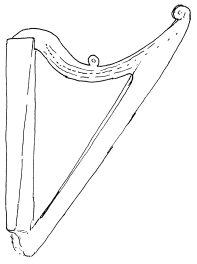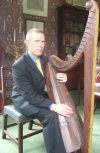

|

May have been made in the late 18th Century
Also known as the Kearney 1 harp
In a private collection in Ireland.
"High Headed" design;
36 strings, longest c.115cm

This harp’s soundbox is pieced from planks rather than carved from a solid block in the usual fashion. The entire instrument is painted all over; there is a yellow-golden strip painted up the front of the pillar, and along the top of the neck. The rest of the harp is painted in a fake wood grain in two shades of brown. The painting looks different on the soundbox to the rest of the harp, and I wonder if the soundbox is a later replacement. Certainly the projecting foot is a later replacemnt, and is combined with a rather ungainly stand.
There are applied scrolls to the side of the neck, and subtle profiling of the pillar to give a vestigial T-section and a step beneath the cheek bands. The pins are brass in the treble (21) and iron in the bass (15); there are remains of strings and toggles inside the soundbox. The cheek bands are iron and the straps and stringband on the soundbox are brass. There are 40 string-holes in the string band. The shortest string is about 8.8cm.
Nicholas Carolan (‘Two Irish harps in County Dublin’, Ceol VII, December 1984) first drew attention to this harp in 1984. He tells us that it was then owned by William Kearney, who acquired it at an auction in Ardee, Co. Louth, in 1975, where it had come from a local country house. This may have been Stephenstown House (Knockbridge, Co Louth). After the death of the last of the Fortescue family, the contents of Stephenstown house were sold at auction by Alain Chawner in Ardee, 16-17 July 1975. I have not yet been able to track down the auction catalogue, or any information about why the Fortescues may have had the harp.
Kearney owned the harp from 1975 until his death in 1999. He loaned it for display at Malahide Castle in the 1980s, which is when Nicholas Carolan saw it. Ann and Charlie Heymann also saw it there and took some photographs.
Mike Billinge (wirestrungharp.com, retrieved Jan 2011) mnentions that the harp was again sold at auction in 1999 after the death of Kearney. The Irish Times, 20th November 1999, reports on the forthcoming sale of Kearney's collection and mentions “two harps, lots 199 and 201 respectively, which, although from different centuries - 18th and 19th - have the same estimate of £2,000-£3,000 each.”. An Adams catalogue lists Lot 199: “An 18th century Irish harp, the case decorated with scrolls, having a large open sound box, 55in high. William Kearney Collection”. The Irish Times, 27th November 1999 reports the sale of an 18th century Irish harp from Kearney’s collection on November 24th, 1999, at James Adams Salerooms, at a price of £4000.
I saw the harp a few years ago, still at that time owned by the 1999 purchaser. I took a number of photographs of it then. I do not know what has become of it now.
Simon Chadwick